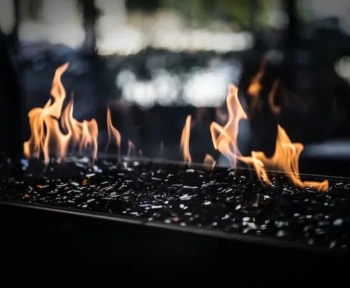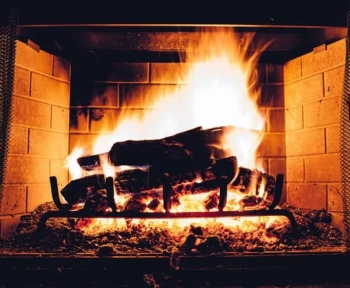Lime washing brick is a process of applying a white wash to brick to give it an aged look. It’s a popular finish for fireplaces because it adds character and charm. The best part about lime washing brick is that it’s easy to do and relatively inexpensive.
1) Begin by preparing your work area
You will need to protect the floor and any nearby furniture or carpet from paint splatters
Cover the floor with a drop cloth or old sheets and tape them down
Move any furniture away from the fireplace that you can
If you cannot move it, cover it with a drop cloth as welly
2) Next, prepare your brick fireplace for painting
Use a wire brush to remove any loose mortar or debris from the surface of the bricks
Be sure to sweep up all of the dust when you are finished
3) Once the bricks are clean, apply a primer to help the paint adhere better
Choose an exterior primer since it will be more resistant to heat and smoke than interior primer
Apply the primer with a paintbrush, making sure to get into all of the nooks and crannies of the bricks
Allow the primer to dry completely before moving on to painting
4) To create your lime wash, mix equal parts water and white latex paint in a large bucket or bowl
Add in 1/2 cup of fresh lime juice and stir until combined
The mixture should have a consistency similar to milk; if it is too thick, add more water until it reaches the desired consistency
5) To apply the lime wash, dip a natural bristle brush into the mixture and then brush it onto the bricks in long strokes, working from top to bottom
Be sure to evenly coat all sides of each brick for best results
3 Easy Steps To Limewash Your Fireplace
Limewash Vs Whitewash Brick Fireplace
There are many ways to update the look of a brick fireplace and two popular methods are whitewashing and limewashing. Both techniques can create a beautiful, aged look for your fireplace but there are some key differences between the two. Here’s a breakdown of whitewash vs limewash to help you decide which is best for your project.
Whitewash is a very simple process where white paint is brushed onto the brick surface and then quickly wiped away. This leaves behind a thin layer of paint that allows some of the brick’s original color to show through. Whitewashing is ideal for creating a subtle, weathered look on your fireplace.
Limewash, on the other hand, is made with hydrated lime mixed with water. It’s applied to the brick surface in much the same way as whitewash but because it’s thicker in consistency, it tends to create a more dramatic effect. Limewashing can give your fireplace an old world feel with a chalky finish that can be easily distressed for added character.
So which one should you choose? It really depends on the overall look you’re going for in your space. If you want something subtle and classic, then whitewash is probably your best bet.
But if you’re looking for something with more personality, then go for limewash!
How to Apply Romabio Limewash
Assuming you would like a blog post discussing how to apply Romabio limewash: Limewash is a beautiful, natural way to add color to your home. It’s made from slaked lime and water, so it’s safe for both indoor and outdoor use.
And because it’s a mineral-based product, it won’t fade in the sun like paint can. If you’re interested in trying limewash, here’s what you need to know about how to apply it. First, you’ll need to choose the right type of lime for your project.
If you’re working with an existing paint job, you’ll want to use Type S hydrated lime. This type of lime is also known as pickling lime or fat lime, and it’s commonly used in masonry work. It has a fine grain that will help it adhere well to painted surfaces.
If you’re starting with bare wood or other unfinished surfaces, you can use either Type S hydrated lime or Type N quicklime. Quicklime is also known as calcium oxide, and it’s more caustic than hydrated lime. You’ll need to take care when handling quicklime, but it can give your project a more distressed look if that’s the effect you’re going for.
Once you’ve chosen your lime, mix it with water according to the manufacturer’s instructions. The ratio of lime to water will vary depending on the type of surface you’re working with and the level of coverage you want. A good rule of thumb is 1 part limewater mixture to 2 parts water for porous surfaces like wood; 1 part mixture to 3 parts water for semi-porous surfaces like brick; and 1 part mixture to 4 parts water for non-porous surfaces like glass or metal.
When mixed correctly, limewash should have the consistency of heavy cream or whole milk.
How Do You Limewash Brick Fireplace?
If you have a brick fireplace that you want to update, limewashing it is a great option. Limewash is a type of paint made with lime and water that gives your fireplace a beautiful, textured look. It’s also easy to apply and doesn’t require any primer or sealer.
Here’s how to limewash your brick fireplace:
1. Start by giving your fireplace a good cleaning. Remove any soot or dirt buildup from the bricks with a vacuum cleaner or soft brush.
2. Once the bricks are clean, mix up your limewash according to the instructions on the packaging. 3. Apply the limewash to the bricks using a paintbrush or roller, working in small sections until all of the bricks are covered. 4. Allow the limewash to dry for at least 24 hours before lighting a fire in your fireplace.
Can You Use Limewash on a Fireplace?
Yes, you can use limewash on a fireplace. It’s a popular way to give an old fireplace a new lease on life. Limewash is made from lime putty and water, and it’s safe to use on fireplaces.
It’s also low-odor and non-toxic, so it won’t off-gas harmful chemicals into your home. To apply limewash to your fireplace, start by cleaning the surface with a mild detergent. Then, using a brush or roller, apply the limewash in thin coats.
Allow each coat to dry completely before applying the next one. Once you’ve applied the desired number of coats, allow the final coat to dry for at least 24 hours before using the fireplace.
Should I Limewash Or Whitewash Brick Fireplace?
When it comes to choosing between limewash and whitewash for your brick fireplace, there are a few things to consider. First, think about the overall look you want to achieve. If you want a more natural look, then limewashing is the way to go.
The slightly opaque finish of limewash allows some of the brick’s natural color to show through, giving it a softer look. Whitewash, on the other hand, gives your fireplace a brighter, more uniform appearance. If you’re not sure which direction to take, try testing out both finishes on a small section of the fireplace first.
This will help you get a feel for how each looks in person and see which one better suits your taste. Another thing to keep in mind is that whitewash can be more difficult to apply evenly than limewash. Because it’s more translucent, any unevenness in application will be more visible with whitewash.
So if you’re not confident in your painting skills, limewashing may be the simpler option. Finally, keep in mind that both finishes will need to be reapplied periodically as they will eventually wear away over time. How often this needs to be done will depend on how much use your fireplace gets – if it’s used frequently, you’ll likely need to touch up the finish more often than if it’s only used occasionally.
In general, eitherlimewashing or whitwashing your brick fireplace isa good wayto giveit an updated look without having tondo too much work (or spending too much money). It really comes down toreference whatlookyou’re goingforandhowmuchmaintenanceyou’rewillingtodoovertime topreservethefinish .
How Do You Limewash a Stone Fireplace?
If your fireplace is in need of a facelift, consider giving it a fresh coat of limewash. Limewash is a type of paint made from limestone that’s been ground into a fine powder. When mixed with water and applied to stone, it gives the surface a beautiful, weathered look.
Here’s how to limewash a stone fireplace:
1. Start by cleaning the fireplace with mild soap and water. This will remove any soot or debris that could interfere with the limewash adhering to the surface.
2. Next, mix up your limewash according to the manufacturer’s instructions. This usually involves adding water to the powdered limestone until you have a thin, pancake batter-like consistency. 3. Once your limewash is ready, apply it to the fireplace using a brush or roller designed for textured surfaces.
Work in small sections and use long strokes to evenly distribute the paint across the stone. 4 . Allow the first coat of limewash to dry completely before applying additional coats if desired .
Depending on how much coverage you want , 2-3 coats should be sufficient . Just be sure to let each coat dry thoroughly before moving on to the next . 5 Finally , once you ’ re satisfied with the results , allow the final coat of limewash to cure for 24 hours before lighting a fire in your newly refreshed fireplace !
Conclusion
If you’re looking to add a touch of rustic charm to your home, look no further than limewashing your brick fireplace! This simple DIY project can be completed in a day, and all you need is some lime paint and a few supplies. Follow these steps and you’ll have a beautiful new focal point in your home in no time.




